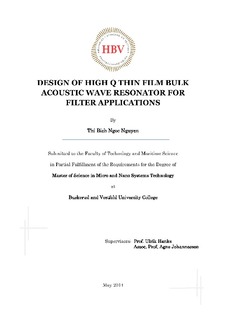| dc.description.abstract | The inevitable propagation of Lamb waves in a traditional Thin Film Bulk Acoustic Wave Resonator (FBAR) leads to the lateral leakage of energy from the active region of the device, and consequently corresponds to a degradation of its quality factors (Q factors). The use of a frame on the periphery of an FBAR is reported to improve the Q factors potentially providing better filter performance for demanding mobile/wireless communication applications. This frame performs as a Bragg reflector which is able to prevent the Lamb waves from leaking to the outside by forcing them to reflect back into the active region of the resonator. A single frame that can reflect one particular Lamb mode has been introduced in literature. This work focuses on a more advanced frame structure for the FBAR. It introduces the procedure to design a dual frame with the ability to reflect the two Lamb modes that presumably contribute most to acoustic leakage – the zero and the first order symmetric mode (S0 and S1).
The displacement field of a W/AlN/W stack FBAR is found from 2D Finite Element Simulations (FEM). Then the dispersion diagrams for the Lamb modes in the active as well as the frame regions are extracted from taking the Fourier transform of the displacement field of the layer stack. From this the lateral propagation constants for the S0 and S1 modes at anti–resonance frequency (fa) are obtained for the various regions. Adopting the diffraction grating method from optics, a single frame designed for dual–mode reflection at can be achieved if the width of the frame is multiples of the quarter wavelengths of both modes. The mentioned dual frame is the combination of these two single frames with different step heights.
FEM simulation results for various frame configurations of the FBAR, including the basic FBAR structure without a frame, the one with a single frame that can only reflect S1 mode, and the ones designed for the dual–mode reflection, involving a single frame and an advanced dual frame are extracted from COMSOL software. These simulations are carried out in order to compare the effectiveness of different frame designs. Among all, the FBAR with a dual frame provides the highest Q factors. In addition, the ripples located at the frequencies near and above fa are suppressed, giving a smoother electrical characteristic of the resonator at these frequencies. | nb_NO |
